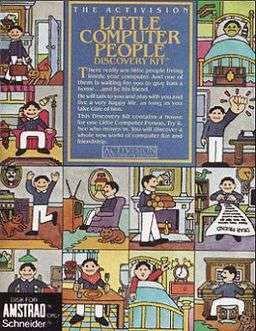Little Computer People
| Little Computer People | |
|---|---|
 | |
| Developer(s) | Activision |
| Publisher(s) | Activision |
| Designer(s) |
David Crane Rich Gold |
| Platform(s) |
ZX Spectrum Commodore 64 Amstrad CPC Atari ST Amiga Apple II PC-9801 PC-8801 |
| Release date(s) | 1985 |
| Genre(s) | Life simulation game |
| Mode(s) | Single player |
Little Computer People, also called House-on-a-Disk, is a life simulation game released in 1985 by Activision for the Commodore 64, Sinclair ZX Spectrum, Amstrad CPC,[1] Atari ST and Apple II. An Amiga version was released in 1987. Two Japanese versions were also released in 1987, a Family Computer Disk System version, published in Japan by DOG (a subsidiary of Square), and a PC-8801 version.
Gameplay
The game has no winning conditions, and only one setting: a sideways view of the inside of a three-story house. After a short time, an animated character (always male, except on the Japanese versions) will move in and occupy the house. He then goes about a daily routine, doing everyday things like cooking, watching television or reading the newspaper. Players are able to interact with this person in various ways, including entering simple commands for the character to perform, playing a game of poker with him and offering presents. On occasion, the character initiates contact on his own, inviting the player to a game or writing a letter explaining his feelings and needs. Each copy of the game generates its own unique character, so no two copies play exactly the same.[1]
The documentation that accompanied the game fully kept up the pretense of the "little people" being real, and living inside one's computer (the software merely "bringing them out"), with the player as their caretaker.
Two versions of the game existed for the Commodore 64: the disk version, which played as described above, and the cassette version, which omitted several features.[2] On tape versions, the Little Computer Person was generated from scratch every time the game was started up (not only on the first boot, as with other versions), and thus did not go through the "moving in" sequence seen on other versions. Also, on cassette versions the Computer Person had no memory, and did not communicate meaningfully with the user; and the card games, such as Poker, could not be played.
Reception
Little Computer People was well received, earning a Zzap! Gold Medal Award in 1985.[3] Jerry Pournelle of BYTE named it his game of the month for December 1986, stating "That's not strictly a game, but it sure has consumed all the game time we have around here" and that the Amiga version's graphics were preferable to the Atari ST's.[4] Compute! favorably reviewed the Atari ST version in 1987, stating that it had "enormous and subtle educational appeal" to children and others. The magazine concluded that Little Computer People "is a delightful program".[5]
Japanese versions
Apple Town Story
| Apple Town Story | |
|---|---|
| Developer(s) | Square |
| Publisher(s) | DOG |
| Designer(s) | David Crane |
| Composer(s) | Nobuo Uematsu[6] |
| Platform(s) | Family Computer Disk System |
| Release date(s) |
|
| Genre(s) | Simulation |
| Mode(s) | Single player |
Apple Town Story (アップルタウン物語) is a port of Little Computer People to the Family Computer Disk System. The port was released by Square of Final Fantasy fame in 1987. Unlike previous versions of Little Computer People, the playable character is a girl wearing a pink dress and bow in her hair. The rooms of the house are also in a different configuration, featuring an outdoor balcony on the top floor. When the game is first played, a name for the character is chosen at random from a preprogrammed list. Apple Town Story lacks many of the features found in other versions of Little Computer People.
PC-8801 version
In December 1987, a second Japanese version of the game was released for the PC-8801 computer, titled Little Computer People (リトルコンピュータピープル). Like Apple Town Story, this game also features a female character, only older and more glamorous in appearance. Aside from the character, this version of the game is far more like the original in all other respects.
Add-Ons
According to "High Score!", add-ons were planned, such as diskettes filled with new furniture and an "LCP Apartment" in an apartment building, with the LCPs all interacting. These add-ons, also described in terms of a sequel expanding on the LCP concept,[7] never materialized.
Legacy
The game was voted best original game of the year at the 1986 Golden Joystick Awards.[8]
Will Wright, designer of The Sims, has mentioned playing Little Computer People, and receiving valuable feedback on The Sims from its designer, Rich Gold.[9]
References
- 1 2 Baker, T. Byrl, Unsung Heroes: Ground Breaking Games – Little Computer People, GameSpot, archived from the original on 2010-07-07, retrieved 2014-10-30
- ↑ http://www.eurogamer.net/articles/little-computer-people-review
- ↑ "Zzap! Test: The Activision Little Computer People Discovery Kit". Zzap!64. Newsfield (7): 8–10. November 1985. Retrieved 2013-05-29.
- ↑ Pournelle, Jerry (December 1986). "The Final Frontier". BYTE. p. 291. Retrieved 9 May 2015.
- ↑ Randall, Neil (March 1987). "Little Computer People". Compute!. p. 70. Retrieved 9 November 2013.
- ↑ "Uematsu's Music". Square-Enix-USA.com. Retrieved 2007-09-01.
- ↑ Kidd, Graham (August 1996). "Get A-Life". Computer Shopper.
- ↑ "Golden Joystick Awards". Computer and Video Games. EMAP (55): 90. May 1986.
- ↑ "Will Wright : A chat about the "The Sims" and "SimCity"". CNN. Retrieved 2006-09-03.
External links
- Little Computer People at MobyGames
- Little Computer People Information Preservation Article filed under Pac-Man's Notes at Pac-Attack.com
- Little Computer People Research Project (extensive information on C64 version) at The-Commodore-Zone
- Legends of the C64 article on David Crane (includes Little Computer People info)
- Technical information on how the random characters were generated at Software Preservation Society
- Little Computer People at World of Spectrum